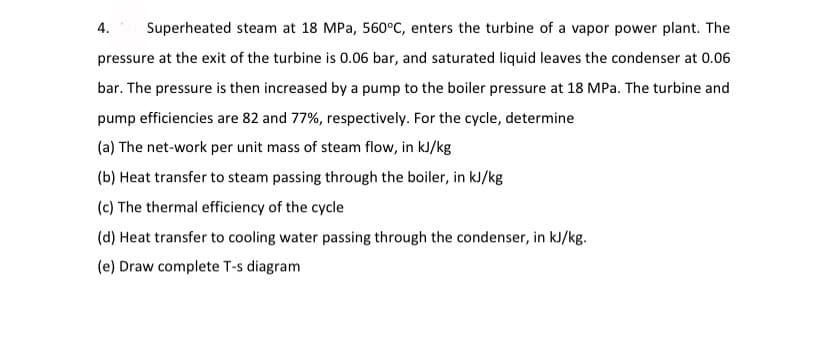4. Superheated steam at 18 MPa, 560°C, enters the turbine of a vapor power plant. The pressure at the exit of the turbine is 0.06 bar, and saturated liquid leaves the condenser at 0.06 bar. The pressure is then increased by a pump to the boiler pressure at 18 MPa. The turbine and pump efficiencies are 82 and 77%, respectively. For the cycle, determine (a) The net-work per unit mass of steam flow, in kJ/kg (b) Heat transfer to steam passing through the boiler, in kJ/kg (c) The thermal efficiency of the cycle (d) Heat transfer to cooling water passing through the condenser, in kJ/kg. (e) Draw complete T-s diagram
4. Superheated steam at 18 MPa, 560°C, enters the turbine of a vapor power plant. The pressure at the exit of the turbine is 0.06 bar, and saturated liquid leaves the condenser at 0.06 bar. The pressure is then increased by a pump to the boiler pressure at 18 MPa. The turbine and pump efficiencies are 82 and 77%, respectively. For the cycle, determine (a) The net-work per unit mass of steam flow, in kJ/kg (b) Heat transfer to steam passing through the boiler, in kJ/kg (c) The thermal efficiency of the cycle (d) Heat transfer to cooling water passing through the condenser, in kJ/kg. (e) Draw complete T-s diagram
Elements Of Electromagnetics
7th Edition
ISBN:9780190698614
Author:Sadiku, Matthew N. O.
Publisher:Sadiku, Matthew N. O.
ChapterMA: Math Assessment
Section: Chapter Questions
Problem 1.1MA
Related questions
Question
letters d and e

Transcribed Image Text:4.
Superheated steam at 18 MPa, 560°C, enters the turbine of a vapor power plant. The
pressure at the exit of the turbine is 0.06 bar, and saturated liquid leaves the condenser at 0.06
bar. The pressure is then increased by a pump to the boiler pressure at 18 MPa. The turbine and
pump efficiencies are 82 and 77%, respectively. For the cycle, determine
(a) The net-work per unit mass of steam flow, in kJ/kg
(b) Heat transfer to steam passing through the boiler, in kJ/kg
(c) The thermal efficiency of the cycle
(d) Heat transfer to cooling water passing through the condenser, in kJ/kg.
(e) Draw complete T-s diagram
Expert Solution
This question has been solved!
Explore an expertly crafted, step-by-step solution for a thorough understanding of key concepts.
This is a popular solution!
Trending now
This is a popular solution!
Step by step
Solved in 3 steps with 1 images

Knowledge Booster
Learn more about
Need a deep-dive on the concept behind this application? Look no further. Learn more about this topic, mechanical-engineering and related others by exploring similar questions and additional content below.Recommended textbooks for you

Elements Of Electromagnetics
Mechanical Engineering
ISBN:
9780190698614
Author:
Sadiku, Matthew N. O.
Publisher:
Oxford University Press

Mechanics of Materials (10th Edition)
Mechanical Engineering
ISBN:
9780134319650
Author:
Russell C. Hibbeler
Publisher:
PEARSON

Thermodynamics: An Engineering Approach
Mechanical Engineering
ISBN:
9781259822674
Author:
Yunus A. Cengel Dr., Michael A. Boles
Publisher:
McGraw-Hill Education

Elements Of Electromagnetics
Mechanical Engineering
ISBN:
9780190698614
Author:
Sadiku, Matthew N. O.
Publisher:
Oxford University Press

Mechanics of Materials (10th Edition)
Mechanical Engineering
ISBN:
9780134319650
Author:
Russell C. Hibbeler
Publisher:
PEARSON

Thermodynamics: An Engineering Approach
Mechanical Engineering
ISBN:
9781259822674
Author:
Yunus A. Cengel Dr., Michael A. Boles
Publisher:
McGraw-Hill Education

Control Systems Engineering
Mechanical Engineering
ISBN:
9781118170519
Author:
Norman S. Nise
Publisher:
WILEY

Mechanics of Materials (MindTap Course List)
Mechanical Engineering
ISBN:
9781337093347
Author:
Barry J. Goodno, James M. Gere
Publisher:
Cengage Learning

Engineering Mechanics: Statics
Mechanical Engineering
ISBN:
9781118807330
Author:
James L. Meriam, L. G. Kraige, J. N. Bolton
Publisher:
WILEY